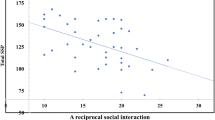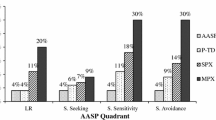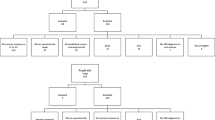Abstract
Objective
To study the prevalence and characteristics of Sensory processing abnormalities (SPAs) in children with autism and to study if there is any correlation between sensory processing abnormalities with FDG-PET findings in children with severe autism.
Methods
One hundred children, aged 3–12 y, diagnosed as Autistic spectrum disorder; ASD (DSM-V) and 100 age and sex matched controls were studied. SPAs were detected using Short sensory profile (SSP) questionnaire. Children with progressive neurological diseases, active epilepsy and structural brain abnormalities were excluded. On Childhood Autism rating scale, 30 children had severe and 70 had mild-moderate autism. The pattern of sensory processing abnormalities in children with severe ASD was compared with mild-moderate ASD. FDG-PET scan was done in children with severe autism and correlated with SPAs.
Results
All children with severe autism had sensory processing abnormalities as compared to only 40% children with mild-moderate autism. Underresponsiveness/seeking-sensation was affected in all children with severe ASD and 82% had movement sensitivity. In children with mild-moderate ASD, 45% had auditory filtering, 30% had movement sensitivity and 27% had underresponsiveness/seeking-sensation. FDG-PET was abnormal in 17% of children with severe autism. Diffuse cerebral/ temporal lobe hypometabolism, increased bilateral frontal lobe uptake and moderate reduction in parietal lobe (Lt > Rt) was observed.
Conclusions
All patients with severe autism had SPAs. However, they did not correlate with FDG-PET findings.

Similar content being viewed by others
References
Tomchek SD, Dunn W. Sensory processing in children with and without autism: a comparative study using the short sensory profile. Am J Occup Ther. 2007;61:190–200.
Watling R, Hauer S. Effectiveness of Ayres sensory integration® and sensory-based interventions for people with autism spectrum disorder: a systematic review. Am J Occup Ther. 2015;69:6905180030p1–12. https://doi.org/10.5014/ajot.2015.018051.
Dilber C, Calışkan M, Sönmezoğlu K, et al. Positron emission tomography findings in children with infantile spasms and autism. J Clin Neurosci. 2013;20:373–6.
Zilbovicius M, Boddaert N, Belin P, et al. Temporal lobe dysfunction in childhood autism: a PET study. Positron emission tomography. Am J Psychiatry. 2000;157:1988–93.
Hall GBC, Szechtman H, Nahmias C. Enhanced salience and emotion recognition in autism: aPET study. Am J Psychiatry. 2003;160:1439–41.
Schopler E, Reichler RJ, DeVellis RF, Daly K. Toward objective classification of childhood autism: childhood autism rating scale (CARS). J Autism Dev Disord. 1980;10:91–103.
Chlebowski C, Green JA, Barton ML, Fein D. Using the childhood autism rating scale to diagnose autism spectrum disorders. J Autism Dev Disord. 2010;40:787–99.
Boyd BA, Baranek GT, Sideris J, et al. Sensory features and repetitive behaviors in children with autism and developmental delays. Autism Res. 2010;3:78–87.
Ben-Sasson A, Hen L, Fluss R, Cermak SA, Engel-Yeger B, Gal E. A meta-analysis of sensory modulation symptoms in individuals with autism spectrum disorders. J Autism Dev Disord. 2009;39:1–11.
Wing L. Sex ratios in early childhood autism and related conditions. Psychiatry Res. 1981;5:129–37.
Frazier TW, Georgiades S, Bishop SL, Hardan AY. Behavioral and cognitive characteristics of females and males with autism in the Simons simplex collection. J Am Acad Child Adolesc Psychiatry. 2014;53:329–40.
Head AM, McGillivray JA, Stokes MA. Gender differences in emotionality and sociability in children with autism spectrum disorders. Mol Autism. 2014;5:19.
Schifter T, Hoffman JM, Hatten HP, Hanson MW, Coleman RE, DeLong GR. Neuroimaging in infantile autism. J Child Neurol. 1994;9:155–61.
Rumsey JM, Duara R, Grady C, et al. Brain metabolism in autism. Resting cerebral glucose utilization rates as measured with positron emission tomography. Arch Gen Psychiatry. 1985;42:448–55.
Hazlett EA, Buchsbaum MS, Hsieh P, et al. Regional glucose metabolism within cortical Brodmann areas in healthy individuals and autistic patients. Neuropsychobiology. 2004;49:115–25.
Zilbovicius M, Garreau B, Samson Y, et al. Delayed maturation of the frontal cortex in childhood autism. Am J Psychiatry. 1995;152:248–52.
Galuska L, Szakáll S Jr, Emri M, et al. PET and SPECT scans in autistic children. Orv Hetil. 2002;143:1302–4.
Brunelle F, Boddaert N, Zilbovicius M. Autism and brain imaging. Bull Acad Natl Med. 2009;193:287–97.
Siegel BV Jr, Asarnow R, Tanguay P, et al. Regional cerebral glucose metabolism and attention in adults with a history of childhood autism. J Neuropsychiatr Clin Neurosci. 1992;4:406–14.
Author information
Authors and Affiliations
Contributions
RAK and JKS were involved in conception of the work, data acquisition, analysis, interpretation of the data and prepared the first draft. PM did the psychological assessments and was also involved in data acquisition. BRM analysed FDG-PET of the patients involved in the study. PS is the Clinician-in-charge, was involved in design, planned and guided the study, and did critical review of the manuscript for intellectual content. The final manuscript was corrected and approved by all authors. PS will act as guarantor for this paper.
Corresponding author
Ethics declarations
Conflict of Interest
None.
Source of Funding
The authors acknowledge PGIMER for research grant to procure the Short sensory profile questionnaire.
Additional information
Publisher’s Note
Springer Nature remains neutral with regard to jurisdictional claims in published maps and institutional affiliations.
Rights and permissions
About this article
Cite this article
Kadwa, R.A., Sahu, J.K., Singhi, P. et al. Prevalence and Characteristics of Sensory Processing Abnormalities and its Correlation with FDG-PET Findings in Children with Autism. Indian J Pediatr 86, 1036–1042 (2019). https://doi.org/10.1007/s12098-019-03061-9
Received:
Accepted:
Published:
Issue Date:
DOI: https://doi.org/10.1007/s12098-019-03061-9




